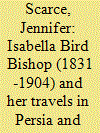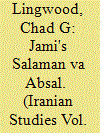|
|
|
Sort Order |
|
|
|
Items / Page
|
|
|
|
|
|
|
| Srl | Item |
| 1 |
ID:
102705


|
|
|
|
|
| Publication |
2011.
|
| Summary/Abstract |
Medieval Persian imperial correspondence (tarassul) remains relatively untapped as a source of historiographical information, due in no small part to its stylized and ornate character. This ornateness, far from being merely an obstructive husk to the useful pith of data within, constitutes a rich source of information in its own right; indeed, the formal aspects of a given letter may significantly alter the ostensible sense of the text. This study examines as a representative case a fathnama sent by Uzun Hasan to Qaytbay on the occasion of the former's victory over Sultan-Abu Sa'id in 1469, here contextualized, translated and subjected to formal analysis with reference to contemporary insha' manuals. For all its submissive rhetoric, the letter's aggressive intent is shown to be activated by its formal structure, which strategically deploys Uzun Hasanid messianic symbolism to challenge the ascendancy of the Mamluk state.
|
|
|
|
|
|
|
|
|
|
|
|
|
|
|
|
| 2 |
ID:
102708


|
|
|
|
|
| Publication |
2011.
|
| Summary/Abstract |
This paper is based on an earlier one about James Baillie Fraser's trip to Khorasan in the 1820s, the first European to travel there in the Qajar era. But instead of focusing on Fraser's experience, the information given by him is used to view the circumstances in Khorasan from an Iranian perspective, which, in turn, is derived from a study of the three main categories of people met by Fraser. Through them and their careers, the paper analyzes the problems, both inherited and new, that the early Qajars faced from the outset. Each of the three categories is dealt with separately under the headings of Prince-Governors, Princes in Exile or in Obeisance and, finally, High Priests. Together these complete the overall picture in Greater Khorasan and, by extension, throughout Iran at that particular time. What emerges from a study of their careers are the seeds of some of the major trends that were to mark nineteenth-century Iran. Khorasan, with its size and position, was particularly well placed to afford a view of a society still dependent on tribal vagaries and the dominant role of the religious hierarchy. Above all, the geo-strategic location of the province affords a privileged view across to the outlying parts of Greater Khorasan which, although still viewed from inside as a part of Greater Iran, were, due to inherent instabilities, liable to manipulation by British and Russian imperialism. The most effective tool of the latter was a propensity to promote new national entities on the ruins of an empire struggling to sustain itself without means and with a dated mindset of which most people were sorely unaware. By projecting the circumstances of time and place onto the future, one can perceive a certain degree of inevitability in the upcoming history of Qajar Iran.
|
|
|
|
|
|
|
|
|
|
|
|
|
|
|
|
| 3 |
ID:
102709


|
|
|
|
|
| Publication |
2011.
|
| Summary/Abstract |
Isabella Bird Bishop was one of the remarkable Victorian women who traveled independently in both Persia and the neighboring countries of the Ottoman Empire. She came to Persia as a very experienced and respected travel writer who had journeyed alone and adventurously in the Americas, Australia, Japan and Malaya. Her travels in Persia in 1890 were possibly the hardest and most challenging of her life. She meticulously observed, recorded and finally published all that she saw-the terrain, meetings with the Qajar court, Bakhtiari and Kurdish tribal chiefs and the families, and the daily life and customs of the people.
|
|
|
|
|
|
|
|
|
|
|
|
|
|
|
|
| 4 |
ID:
102704


|
|
|
|
|
| Publication |
2011.
|
| Summary/Abstract |
This article explores Salaman va Absal , one of seven poems which comprise Jami's collection of long masnavis, known collectively as the Haft aurang. The work, which gained some renown outside Iran due to the English version of Edward FitzGerald, has nevertheless received little attention in modern scholarship. The few investigations of Salaman va Absal moreover, have dwelled on its narrative, which tells the story of the carnal attraction of a prince for his wet-nurse, and never situated the work in its historical context or examined its political content. In addition, the allegorical symbolism of the tale, especially its depiction of key stages of the Sufi path, such as the act of repentance, has not been discussed in terms of representing a work of mystical advice. With these concerns in mind, the present article discusses the possibility that the political elements in Salaman va Absal, complement the advice it gives on becoming a Sufi. Seen from this perspective, it would appear that Salaman va Absal correlates the notion of the just ruler to the Sufi concept of the "Perfect Man" to the extent that Jami's presents the Sufi-king as the ideal medieval Islamic ruler. By implication, the work advises its royal patron, Sultan Yaqub, to repent and embark upon the Sufi path, doing so, Jami intimates, would lead Ya'qub to realize his rank as God's "true" vicegerent.
|
|
|
|
|
|
|
|
|
|
|
|
|
|
|
|
| 5 |
ID:
102711


|
|
|
|
|
| Publication |
2011.
|
| Summary/Abstract |
The coincidence of the appearance of two Circassian women as wives of ambassadors on the Anglo-Persian diplomatic and political stage has generated more than passing interest in academic and lay literature. Though the story of Sir Robert Sherley and Lady Teresia Sherley is better known in British circles, and has even generated renewed interest with two simultaneous exhibitions in 2009 in London, the story of Fath Ali Shah's Ambassador to the Court of St. James, Abol Hassan Khan, has not received sufficient attention, and has certainly not been fully explored in the context of the politics of Regency England. The present article revisits key moments of the life of the Sherleys and of Abol Hassan Khan and Delaram, his Circassian wife, but goes beyond the retelling of their journeys to focus on how the latter two's visit to England generated bawdy depictions in the popular press and became the vehicle for political satire quite unconnected to their persons.
|
|
|
|
|
|
|
|
|
|
|
|
|
|
|
|
| 6 |
ID:
102703


|
|
|
|
|
| Publication |
2011.
|
| Summary/Abstract |
In the shop-lease contract with sar-qofli, which is a widely practiced form of lease contract in today's Iran, a lessor of a shop sells to a hirer a right called sar-qofli which amounts to almost as much as the entire value of the shop's ownership, while obtaining a monthly rent of only small value. This peculiar form of contract was brought into existence based on a new right called "haqq-e kasb o pishe o tejarat," that emerged as a result of the blending of traditional customary practice relating to real estate leasing with Anglo-American value concepts. The adoption of this right, causing as it did the lessor's responsibility for compensation for the value of the usufructuary right, drastically changed the relationship between lessors and hirers in Iran.
|
|
|
|
|
|
|
|
|
|
|
|
|
|
|
|
|
|
|
|
|